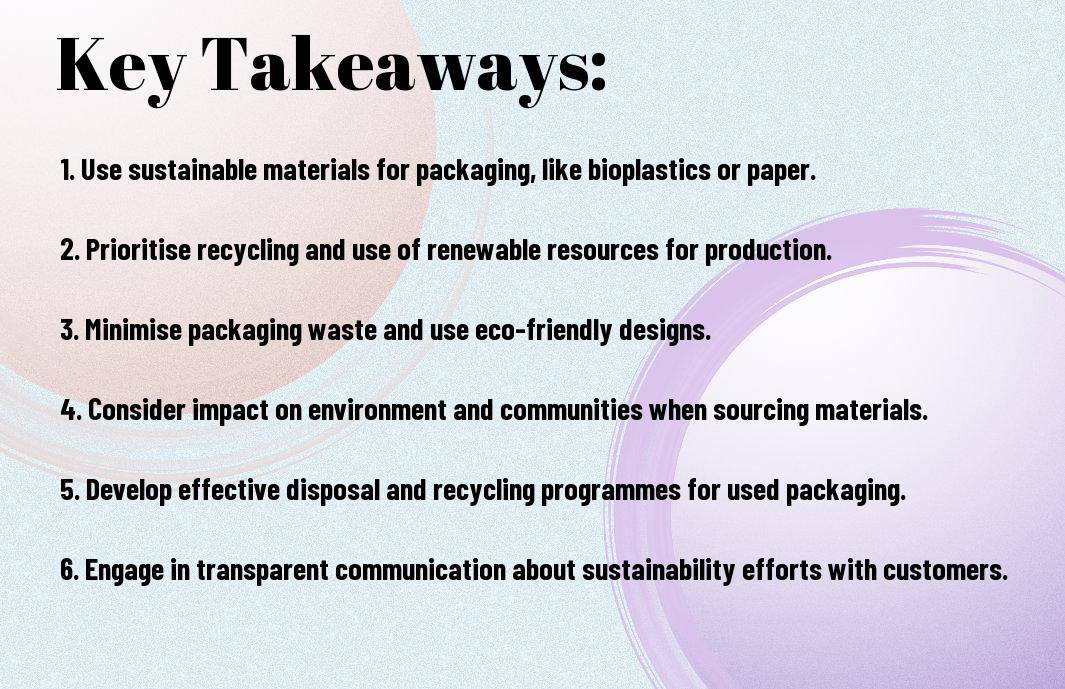Congratulations on taking an interest in the sustainable management of packaging in the food and drink industry. It’s crucial that you consider the environmental impact of your packaging materials and processes, from the moment of sourcing to final disposal. By incorporating sustainable practices, you not only reduce carbon footprint but also contribute to a healthier planet for future generations. In this blog post, we will explore the various steps and strategies you can take to integrate sustainability into the entire packaging lifecycle of your products.
Key Takeaways:
- Transparent sourcing: Food and drink companies should prioritize partnering with suppliers who offer ethically sourced and sustainable packaging materials. This includes materials that have minimal environmental impact and are sourced from responsible suppliers.
- Invest in innovation: Companies should invest in research and development to find innovative and sustainable packaging materials. This could include biodegradable or compostable packaging alternatives, as well as reusable or refillable options that reduce overall waste.
- Collaborate with stakeholders: Collaboration with stakeholders, including consumers, industry partners, and waste management facilities, is crucial for successful integration of sustainability in packaging. Engaging with these stakeholders can offer insights into consumer preferences, improve waste management systems, and foster a culture of sustainability throughout the supply chain.

Sourcing and Designing Sustainable Packaging
When it comes to integrating sustainability into the packaging lifecycle of food and drink products, the process starts right from the sourcing and designing of the packaging materials. This is where crucial decisions are made that can significantly impact the environmental footprint of the final product.
The Essential Factors of Sustainable Sourcing
When sourcing materials for your packaging, it is crucial to consider the environmental impact of the materials. Look for suppliers that offer recycled and renewable materials such as paper, cardboard, glass, and biodegradable plastics. Ensure that the materials are sourced responsibly, with a focus on reducing carbon emissions and minimising waste. Additionally, ethical sourcing practices such as fair trade and supporting local communities should also be taken into account. As you evaluate potential suppliers, consider their commitment to sustainability and the certifications they hold, such as Forest Stewardship Council (FSC) for paper and cardboard products. By choosing suppliers who align with these values, you can significantly reduce the environmental impact of your packaging.
- Recycled and renewable materials
- Reducing carbon emissions
- Ethical sourcing
Though it may require more effort and research, sourcing sustainable materials is essential in promoting a circular economy and reducing the overall impact of your packaging.
Innovative Design Solutions for Sustainable Packaging
Designing sustainable packaging involves creating solutions that are both environmentally friendly and practical for your products. This could mean minimising material usage by choosing lightweight yet sturdy materials, or designing packaging that can be easily recycled or composted. Additionally, incorporating biodegradable or compostable materials into your packaging design can significantly reduce the environmental impact at the end of the product’s lifecycle. By prioritising innovative design solutions, you can ensure that your packaging is not only sustainable but also aligns with consumer preferences for eco-friendly products.
Manufacturing and Distributing Sustainable Packaging
When it comes to integrating sustainability into the entire packaging lifecycle of food and drink products, the manufacturing and distribution stages play a crucial role. By implementing sustainable practices in these areas, you can significantly reduce the environmental impact of your packaging. According to a report by McKinsey & Company on Sustainable packaging: Five key levers for impact, there are several key levers that companies can utilise to achieve significant impact in the sustainability of their packaging processes.
Green Manufacturing Techniques in Food and Drink Packaging
Implementing green manufacturing techniques in the production of food and drink packaging can greatly reduce your environmental footprint. This includes using recycled materials, designing packaging to be more lightweight, and reducing the energy and water consumption during the manufacturing process. By adopting these practices, you can significantly decrease the use of raw materials and energy consumption in your manufacturing process, ultimately lowering your carbon emissions and minimising waste.
Distribution and Logistics: Opportunities for Sustainability
When it comes to distributing your sustainable packaging, there are numerous opportunities for improving sustainability. Utilising more efficient transportation methods, such as consolidating shipments and using alternative fuels, can significantly reduce the carbon footprint of your distribution network. Furthermore, implementing strategies to reduce packaging waste during transport and finding ways to increase the recyclability of transport packaging can also have a positive impact on your overall sustainability efforts.
Consumer Use and Disposal of Sustainable Packaging
As a food and drink company looking to integrate sustainability into your packaging lifecycle, it is crucial to consider how consumers use and dispose of your packaging. This phase plays a significant role in determining the environmental impact of your products.
Effective Communication of Sustainability to Consumers
When it comes to sustainable packaging, effective communication with consumers is key. You have to ensure that your packaging clearly displays any eco-friendly credentials and information about how it can be disposed of responsibly. This includes using clear and concise labelling, symbols, and messaging to inform consumers about the sustainable features of the packaging and how they can contribute to its proper disposal.
The Role of Consumers in the Disposal of Packaging
It’s important to recognise the role that consumers play in the disposal of packaging. You can encourage them to participate in sustainable practices by providing clear instructions on how to recycle or dispose of the packaging responsibly. By educating consumers about the environmental impact of their choices and the benefits of proper disposal, you can empower them to make more sustainable decisions.
This inclusive approach can also help build trust and brand loyalty, showing consumers that you are committed to sustainability throughout the entire lifecycle of your products. You can lead the way in reducing single-use plastic waste and promoting a circular economy by implementing sustainable packaging solutions and engaging with consumers to ensure they are part of the solution. It’s time to take responsibility and work towards a more sustainable future for our planet.
Case Studies and Examples of Success
When it comes to integrating sustainability into the entire packaging lifecycle, there are several food and drink companies that have successfully implemented strategies to achieve this. Below are some inspiring case studies that demonstrate how companies can effectively integrate sustainability into their packaging while achieving positive outcomes:
- 1. Unilever: Unilever has made significant strides in sustainable sourcing by committing to sourcing all its agricultural raw materials sustainably by 2020. The company has also achieved zero waste to landfill across its factories, demonstrating a commitment to sustainable manufacturing.
- 2. Coca-Cola: Coca-Cola has set ambitious targets to recover and recycle the equivalent of 100% of its packaging by 2030. The company has also invested in sustainable packaging innovation, such as the PlantBottle, which is made from renewable plant materials.
- 3. Nestlé: Nestlé has made substantial progress in reducing its environmental impact by implementing a zero-deforestation policy and using sustainably sourced materials in its packaging. The company has also committed to making all of its packaging recyclable or reusable by 2025.
Inspiring Examples of Sourcing, Manufacturing, and Packaging Sustainability
These companies have successfully integrated sustainability into their entire packaging lifecycle by implementing sustainable sourcing practices, adopting environmentally friendly manufacturing processes, and utilising eco-friendly packaging materials. By following their example, you can learn how to make sustainable choices at every stage of your packaging lifecycle.
Outcomes, Challenges, and Lessons Learned from Real-World Cases
By examining the outcomes, challenges, and lessons learned from these real-world cases, you can gain valuable insights into the benefits of integrating sustainability into your packaging lifecycle. These case studies highlight the importance of setting ambitious sustainability targets, investing in innovative solutions, and collaborating with stakeholders to achieve meaningful and lasting change.
Conclusion
From above, it is evident that food and drink companies have a significant role to play in integrating sustainability into their entire packaging lifecycle. By implementing sustainable sourcing practices, reducing packaging waste, and using eco-friendly materials, you can effectively reduce the environmental impact of your products. Additionally, you can also explore options for recyclable packaging and invest in innovative technologies for biodegradable packaging solutions. By taking a holistic approach to sustainability, you can set a positive example for the industry and contribute towards a more environmentally friendly future.
FAQ
Q: Why is it important for food and drink companies to integrate sustainability into their packaging lifecycle?
A: It is crucial for food and drink companies to integrate sustainability into their packaging lifecycle to reduce environmental impact, meet consumer demand for eco-friendly products, and comply with regulations on waste management and sustainable practices.
Q: How can food and drink companies source sustainable packaging materials?
A: Food and drink companies can source sustainable packaging materials by working with suppliers who offer eco-friendly options, such as biodegradable or recyclable materials. They can also consider using innovative materials, such as plant-based plastics or compostable packaging.
Q: What steps can food and drink companies take to reduce packaging waste in their operations?
A: Food and drink companies can reduce packaging waste by implementing efficient packaging designs, using materials that minimize excess packaging, and implementing recycling programs for both their packaging and post-consumer waste.
Q: How can food and drink companies ensure the responsible disposal of their packaging materials?
A: Food and drink companies can ensure responsible disposal of their packaging materials by working with waste management partners to properly recycle or dispose of their packaging. They can also educate consumers on how to properly dispose of their packaging to minimize environmental impact.
Q: What are the benefits of integrating sustainability into the entire packaging lifecycle for food and drink companies?
A: By integrating sustainability into their packaging lifecycle, food and drink companies can improve their brand image, reduce costs through efficient packaging and waste management, and contribute to a healthier environment for future generations.

